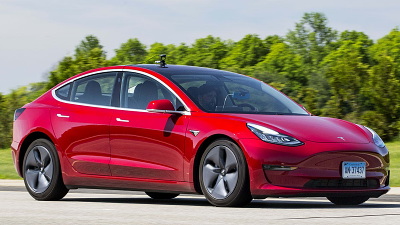How is software becoming more important in the automotive industry?

In recent years, global semiconductor shortages
How Software Is Eating the Car --IEEE Spectrum
https://spectrum.ieee.org/cars-that-think/transportation/advanced-cars/software-eating-car
◆ Increase in in-vehicle software
'No other industry is undergoing as rapid technological change as the automotive industry,' said Zoran Filipi, an automotive engineering researcher at Clemson University in the United States. He pointed out that software is becoming more important to meet the demand for improved comfort. According to IEEE Spectrum, vehicles equipped with the development of in-vehicle infotainment, control of various parts of the vehicle, various driving control devices and safety devices execute tens of millions of lines of code just for a round trip of shopping. ..
Around 2010, only a handful of premium cars were equipped with more than 100 microprocessor-based electronic control units (ECUs) and running software with more than 100 million lines of code. However, at the time of writing the article, luxury cars such as the BMW 7 Series equipped with Advanced Driver Assistance Systems (ADAS) were equipped with more than 150 ECUs, and the Ford pickup truck F-150 was 150 thousand. It seems to execute more than a line of code.

In recent years,
Consulting firm Deloitte Touche Tohmatsu Limited estimates that as of 2017, 40% of new car costs will come from semiconductor-based electronic systems (PDF file) , doubling the cost of electronic systems since 2007. Pointed out that. The cost of electronic systems in vehicles will continue to rise, and is expected to account for 50% of the cost in 2030.
'Software used to be part of the car, and now it determines the value of the car,' said Manfred Broy, a leader in automotive software and an emeritus professor at the Technische Universität München. Success depends more on software than on the mechanical side, 'he said. In recent years, most vehicle innovation has been tied to in-vehicle software rather than mechanical mechanisms.

◆ Difficulty in testing software
Many automakers sell different models of cars in multiple countries and continents, but there are subtle differences between regions and buyers, even for the same model. This is due to differences in government regulatory requirements in each region and the options each owner chooses when ordering, and it is said that it is impossible to keep track of all the variations that can be sold by automakers.
In recent years, due to the increasing complexity of vehicle mechanisms and software, the cost of system integration and testing during the development stage has increased. Deloitte Touche Tohmatsu Limited estimates that more than 40% of the vehicle development budget could be spent on system integration, testing, and validation. In-vehicle software and ECUs that run it must be placed near interacting sensors and actuators such as braking systems and engines, and the physical constraints are said to be a burden on automakers.
In some cases, even if the automaker does as much testing and verification as possible, it is not until the customer's order that a vehicle with a particular electronics or optional configuration is made. As a result, in 2019, General Motors will recall a
Exacerbating this problem is that many automakers outsource their software to their suppliers rather than developing it in-house. In many cases, a particular supplier develops only one of a wide variety of software, such as 'in-vehicle infotainment system software,' 'vehicle body control software,' and 'software related to autonomous driving support functions.' It seems difficult to predict what kind of problems will occur at the integration stage.
In recent years, hacking through in-vehicle software has also become a problem, and hackers often report methods for remotely controlling automobiles. As the software grows, so does the potential attack target, so the government imposes cybersecurity obligations on automakers, and automakers update their software if they detect anomalies. It corresponds with.
Vulnerability to operate a car from a smartphone is discovered again, and a demonstration of brake operation will be held at Corvette --GIGAZINE

◆ ECU and software related failures
Due to the increase in ECUs and software installed in vehicles, the number of recalls caused by these is also increasing. According to a report compiled by advisory firm Stout Lysius Ross , as many as 15 million vehicles were recalled for electronic component defects in 2019, about half of which were related to software-related defects. thing. In addition, it seems that software updates were used to fix defects that are not caused by software at a rate of 50% or more.
It has been pointed out that the introduction of electronic components and software has helped reduce the overall number of recalls, but the proportion of electronic components in the repair cost in the event of a breakdown is also high. Further, if the vehicle with advanced safety features has collided work related electronic parts 60% repairs it occupies when normal component is damaged if addition, the portion where an electronic component is mounted is damaged You will be charged a higher cost than that.
In recent years, as the cost of repairing vehicles equipped with electronic components has increased, it has been pointed out that insurance companies have given up on repairs by replacing parts, and the criteria for judging vehicles as 'total loss' have been lowered. .. A report released by claims management firm Mitchell International shows that rising repair prices for vehicles with electronic components have reduced the average age of vehicles declared to be total losses. It has been.

◆ Increased complexity due to the introduction of electric vehicles and AI
Growing interest in climate change has forced automakers to move from gasoline-powered vehicles to electric vehicles, which require complex software, and combined with increasing attention to AI-powered autonomous driving capabilities, in-vehicle software complexity. The car is accelerating year by year. Consulting firm McKinsey & Company points out that in-vehicle software complexity has quadrupled in the last decade, and is likely to triple in the next decade. And that.
On the other hand, McKinsey & Company says that the productivity of automakers and suppliers has not increased as a result, and that complexity has increased faster than the ability to develop new software and maintain existing software. Says. Automakers are beginning to feel the limits of traditional methods of outsourcing and later integrating software, and it will be important to organize and maintain software teams with the right expertise in the future. Is believed to be.
Related Posts:







